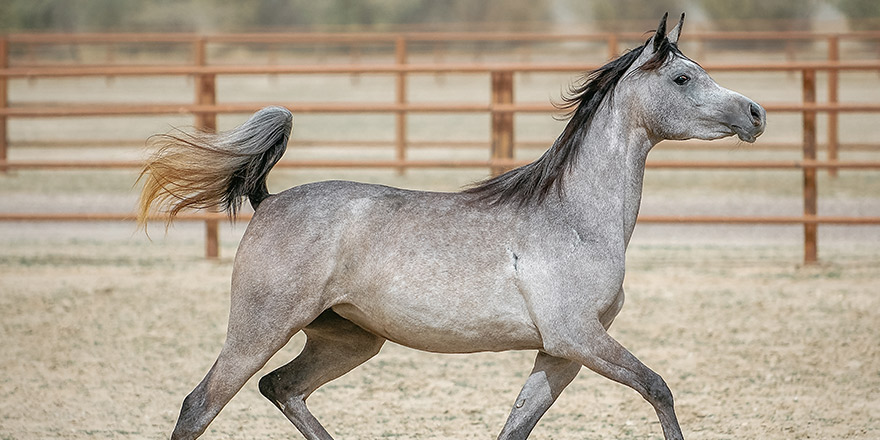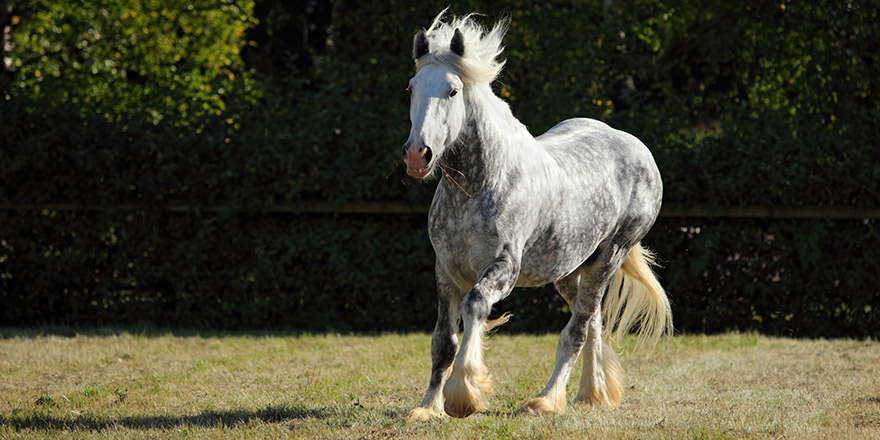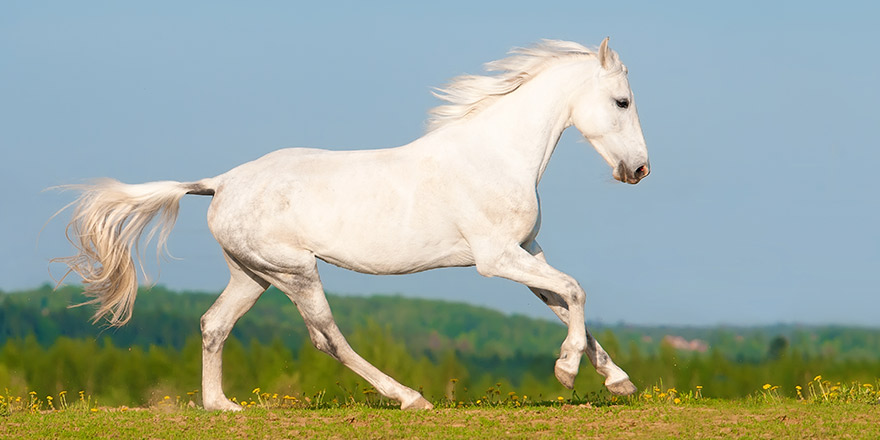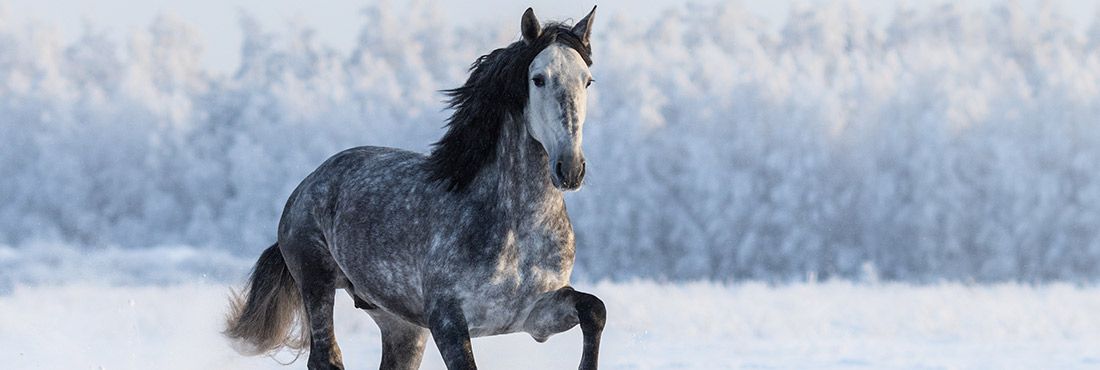Horses are beautiful, elegant, and intelligent animals with an incredible amount of fanatics all over the world. They are known to come in a variety of stunning colorings including chestnut, bay, white, black, and grey but have you ever wondered about a grey spotted horse in particular? Where do these spots come from? What are dapples? How do horses get dapples?
If you’re curious about the dapple grey horse, read on to find out more about what makes these beautiful animals unique and what breeds are likely to produce more of these freckled foals.
What is a Dappled Horse?

The first thing to understand is that a dappled horse is not an individual breed. In fact, dapple is a horse coloration where dark rings of light and dark hairs are present across the horse’s body. It can prominently occur in many different breeds of horses that have a grey coat color. However, other horses with different coat colors have been known to develop faint dappling depending on their condition, diet, and grooming regime.
True Dapples VS Bloom Dapples
True dapples are rings that form due to the horse’s genes whereas bloom dapples are rings that can appear as a result of their health and diet. Bloom dapples are rare in horses and can disappear after some time. However, this doesn’t stop some horse lovers from adjusting their horse’s diet in an attempt to get bloom dapples to occur.
The Gray Gene
The overall coat color of dapple grey horses is the result of the dominant gray gene which is also responsible for the fading of the base color. Essentially, this gene isn’t a coloration gene but is actually a dilution gene and will override the other color gene that exists within the coat. Also, the other color gene is essentially what influences the base color that the horse is born with.
How Long Have Dapple Gray Horses Been Around?
From our research, it is said that horses that carry the gene can be traced back to a single horse that existed over 2000 years ago. Since then, the responsible gene has spread resulting in an increase in the beautiful animals.
How Much does a Dapple Grey Horse Cost?
Any horse owner will agree that any horse breed will not be cheap, let alone one with dappling. The cost of a horse will depend greatly on its training, background, condition, and pedigree. You may find that gray foals or foals expected to form dapples will cost a little more than average due to the demand for dapple grey horses.
Typically, the price of these horses will be in the thousands with prices starting at $3500. Not to mention, owners will have to anticipate the costs for future expenses including food, training, insurance, medical care, homing, and more.
Dapple Grey Horse Appearance

The dapple gray horse is a much sought-after animal and for good reason. The gray coat color genes of the horse make it stand out from others, especially since they can be born with almost any base color that will eventually turn grey and then into pure white as they age further.
Body
The dapple gray horse will not only possess the gene to dilute their hairs, but they will also develop freckles. These will be speckled across their body including their necks and legs. The size and volume of the dapples will vary from horse to horse.
Tail & Mane
The mane and tail of a dapple gray horse won’t show any signs of dappling or freckling but will typically match the overall coat color of the horse. Generally, they will be a shade of gray.
Skin Color
A lot of sources may state that dapple grey horses will have black skin. However, whereas black skin is common with grey hair and dappling, these horses can have other base skin colors also. The skin color is not affected by the grey gene.
Eye Color
A grey dapple’s eye color is also not affected by the grey gene. Typically, these horses will have dark eyes that will remain so throughout their lives.
The Effect of Dappling on Other Physical Features
When an animal has a gene or physical attribute that sets them apart from others it’s normal to wonder if this trait has any effect on its health or other body parts. Here, we’ve broken down whether or not the dapple-gray horse has any other unique characteristics or if there are any health concerns you should know if you’re considering owning one of the beautiful creatures.
Weight & Height
The gray coat gene only has an influence on the coat itself and has no proven effect on the horse’s height or weight. Instead, these attributes will be dependent on the breed of the horse itself and not the gene.
Health Concerns & Lifespan
Much like weight and height, the gene also doesn’t take any toll on a dapple-gray horse’s life span either. Horses generally live anywhere between 25 and 30 years sometimes longer if they are well looked after.
In terms of health, the dapple grey horse can fall ill in the same conditions as other horses. However, it is speculated that these horses are more likely to develop melanoma compared to other horse breeds or colors.
Melanoma
This skin condition can be more common in horses over the age of seven and can cause the skin to form black and/or dark grey nodules. These often occur on the head and neck and will often be benign. However, it’s recommended to have these checked as they have the potential to be malignant.
The Color Changing Process

Interestingly, the gene responsible for the grey dapple has an almost unique effect on the hair of the horse during different stages of its life. For example, older grey horses are often mistaken for white horses as, over time, they develop a completely white coat.
Foal Colors
Contrary to what you might think, dapple grey horses are not born gray. They are also not born with dapples. A foal coat can be from an array of base colors including chestnut, bay, black, and more. Regardless of this base coat color, if the foal carries the gray gene, you will be able to observe silver hairs circling the foal’s eyes.
Eventually, the hair around the muzzle and eyes will begin to lighten. Soon after, the dilution gene will begin to kick in. This will result in the coat becoming grey. However, depending on the base color of the foul, the shade of grey will vary completely. For example, foals born with a chestnut color will lighten to a rose gray color, whereas black foals will turn into a steel gray shade or even iron.
Young Adult Horses
Soon after the dilution gene takes effect, these young gray horses will begin to form dapples. This is typically when they reach anywhere between two and four years of age. The dapples themselves will scatter all over the horse’s body and can become more prominent during adulthood. However, these beautiful spots don’t last forever.
Later Stages
Sadly, as a dapple horse ages, its hairs will eventually turn white. Since the dapples are more prominent between ages two and six, a lot of these horses will begin to turn white shortly after. However, there is no set age or rule as to when a horse will definitely start to turn white as it differs from horse to horse.
The Difference Between a Grey and White Horse
Some will confuse an aged dapple grey horse with a white horse but there are two significant differences between the two. White horses will have blue eyes and pink skin whereas grey horses will be born with different colors that will be replaced with white hairs as they mature. They will also have darker eyes.
Flea-Bitten Gray Pattern
Generally, this coloration will occur after a gray horse has turned white. Flea bitten grays will have a speckled or freckled pattern on their coat. The density and volume of the freckles can vary between horses but can also increase as the horse ages.
Dapple Gray Horse Breeds
If you’re particular about this horse coat shade and are on the lookout for breeds that will produce gray offspring, take a look at the following list. All of the horses below are known to carry the genes as well as endearing personality traits that appeal to horse enthusiasts.
Andalusian Horse

Andalusians are notoriously intelligent, athletic, elegant, and one of the oldest horse breeds around. Around 80% of these horses in the US are said to be grey but can be seen in an array of different coat colors including bay, chestnut, black, and dun.
Arabian Horse

Arabian horses are a gentle breed known for their approachable nature making them perfect for beginner riders. They are an incredibly popular breed in the US and are also known for their stamina and athleticism.
These horses are known to come in a variety of coat colors but can also develop a dapple grey coat. This, coupled with their loveable and kind personalities, makes them a very sought-after and well-loved horse breed.
Check out our article on the Arabian Horse breed for more information.
Percheron Horse

Percheron horses are common with black or gray coats but can also be roan, bay, or even chestnut. These noble and athletic horses were originally bred in France to be war horses.
Lipizzaner Horse

A huge majority of Lipizzaner horses carry the gray gene meaning that these horses will have gray coats. This is due to years of selected breeding as the horse is said to go back centuries. Lipizzaner horses eventually turn gray after around six years and are typically born bay or black.
Irish Sport Horse

This majestic horse breed is commonly used for competitions. Physically, they are muscular and strong and have an elegant structure. Although they can produce black, chestnut, and roan foals some can also carry the grey gene resulting in a dapple-gray horse.
Orlov Horse

It is said the Orlov horses are related to the Arabian breed which gifts them with grey genes. Generally, Orlovs breed black and dapple grey horses but they have been known to have bay or chestnut coats. Just under 50% of Orlavs are dapple gray whereas the next common coat color is black followed by bay and chestnut.
Other Horse Breeds That Can Develop Dapples:
- Thoroughbred
- Welsh Pony
- American Quarter Horse
- Oldenburg
- Dilbaz
- Lusitano
- Camargue
Breeds More Likely To Produce A Dapple Grey Horse
As you can see, many breeds of horses can produce grey coats and dapples. However, the most common breeds to produce a gray foal include the Lipizzaner, Percheron, and Andalusian.
Frequently Asked Questions
Grey horses are quite common as many horse breeds can be grey in color. However, dapple grey horses are considered one of the most popular and sought after.
Dapple gray horses are prone to the same health conditions as other horses. However, it is said that they are more likely to develop melanoma later in life.
Typically, you may only come across grey horses with dappling. However, it is possible for horses of other colors, such as chestnut horses, to have faint dapple markings. Good grooming and nutrition may enhance their appearance.
Foals are never born with dapples as they are typically born with a base color (chestnut, dark bay, dun, etc.) and within days or months, white hairs begin to sprout indicating an oncoming change of color.
Most dapple grey horses will eventually turn white as the horse ages. However, it is possible for a horse to keep their color. This is incredibly rare, but not impossible.
This coat color is the result of the silver dapple gene which is not the same as the grey gene as it dilutes only a black coat, changing it to dark brown or a flaxen shade. Unlike gray horses, silver dapples will not continue to dilute as horses age.







